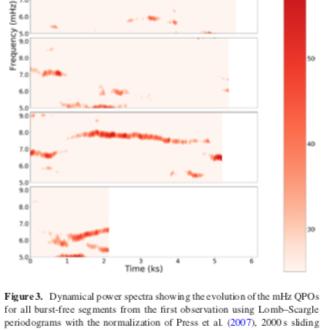Keeping the "beat" of nuclear burning
 Millihertz quasi-periodic oscillations (mHz QPOs) observed in neutron-star
low-mass X-ray binaries are generally thought to arise from
"marginally stable" thermonuclear burning, at the upper limit of
accretion rates where
thermonuclear
bursts are possible. A long-standing puzzle is that they seem to occur
at accretion rates about an order of magnitude lower than predicted
theoretically, and while bursts are still occurring.
Millihertz quasi-periodic oscillations (mHz QPOs) observed in neutron-star
low-mass X-ray binaries are generally thought to arise from
"marginally stable" thermonuclear burning, at the upper limit of
accretion rates where
thermonuclear
bursts are possible. A long-standing puzzle is that they seem to occur
at accretion rates about an order of magnitude lower than predicted
theoretically, and while bursts are still occurring.
Since no-one knows how you can simultaneously have (quasi-) stable and unstable burning on the surface of a neutron star (except perhaps Yuri Cavecchi), we'd dearly like to better understand this phenomenon. Monash PhD student Ka Ho Tse discovered a new example of mHz QPOs, in the transient 1RXS J180408.9—342058. While the properties of the newly-discovered oscillations are similar to the other seven examples, we now have a good sample of objects to examine the properties and compare against (for example) numerical models. Ka Ho's preliminary work suggests the observed amplitude is much higher than would be predicted theoretically, which presents a challenge for the conventional interpretation.
His paper describing the discovery, and exploring some of the implications for the phenomenon across all sources, has now been published by MNRAS.
Read the paper (MNRAS 500, 34—39, 2021)
Labels: 2020, /postgrads




